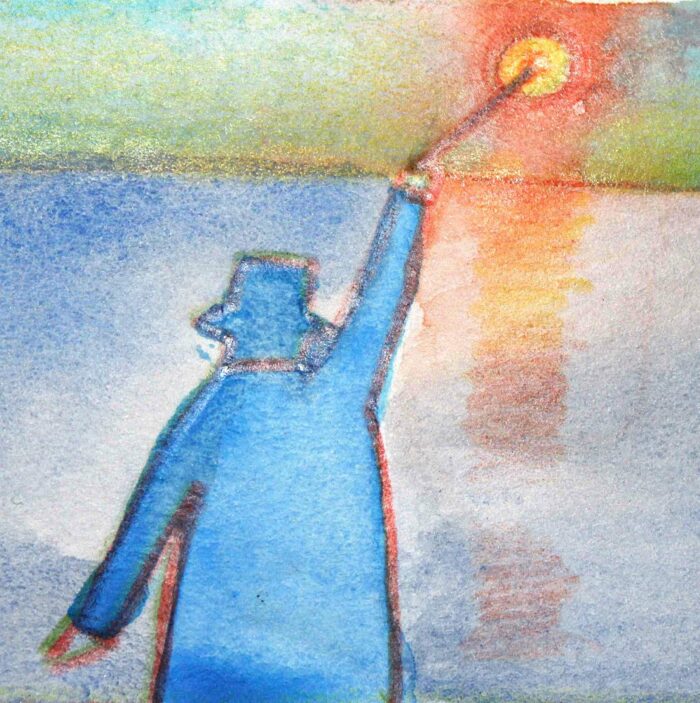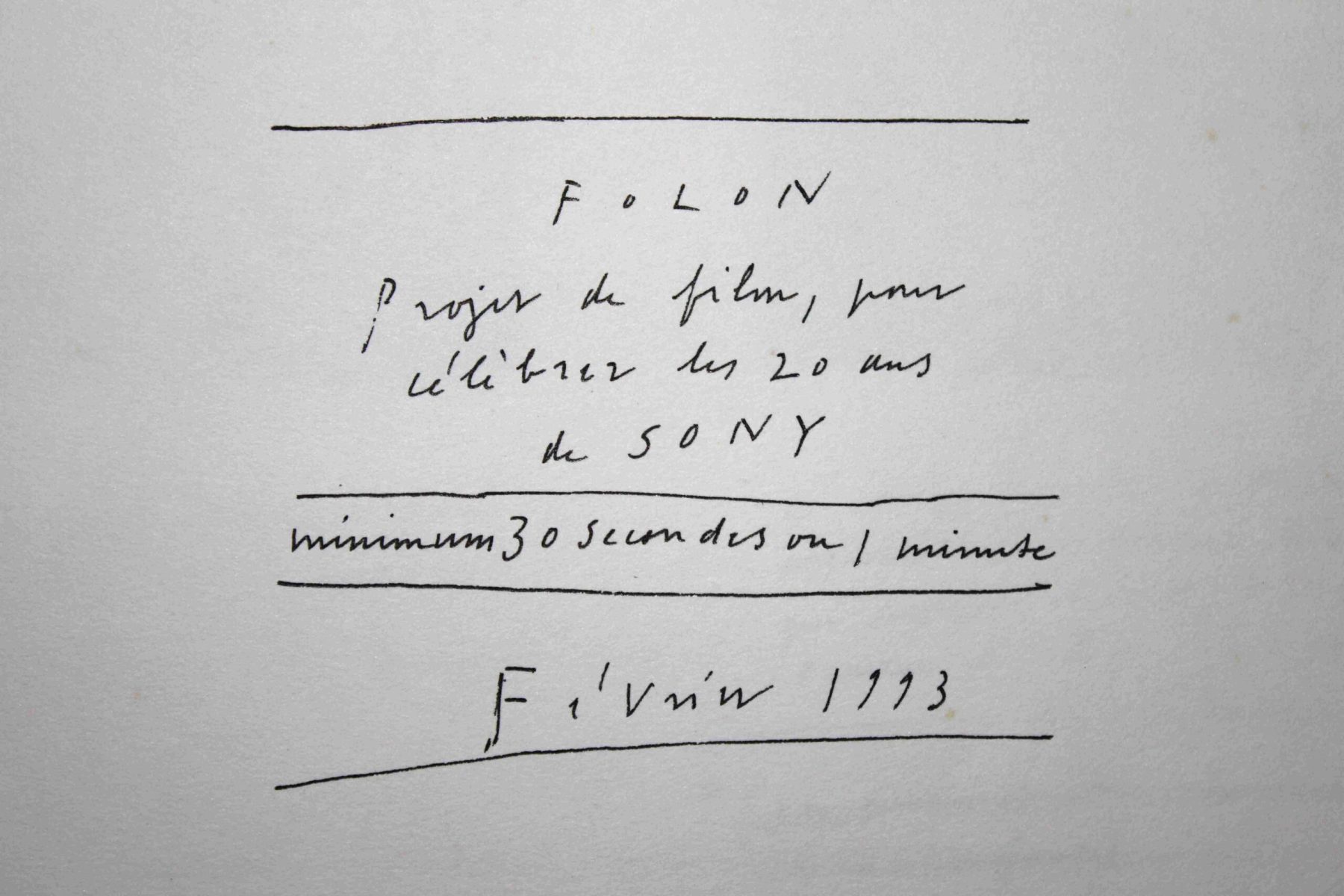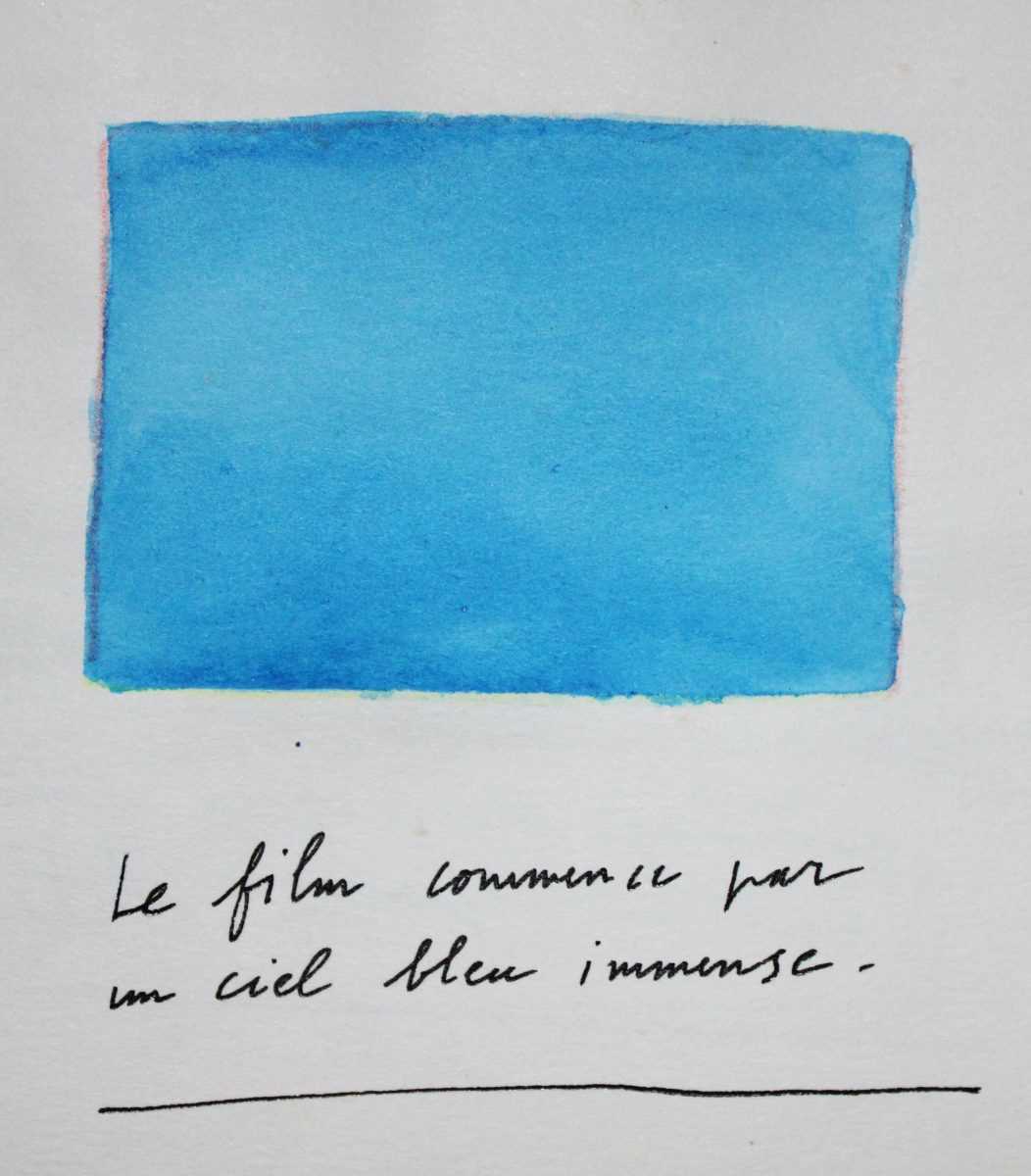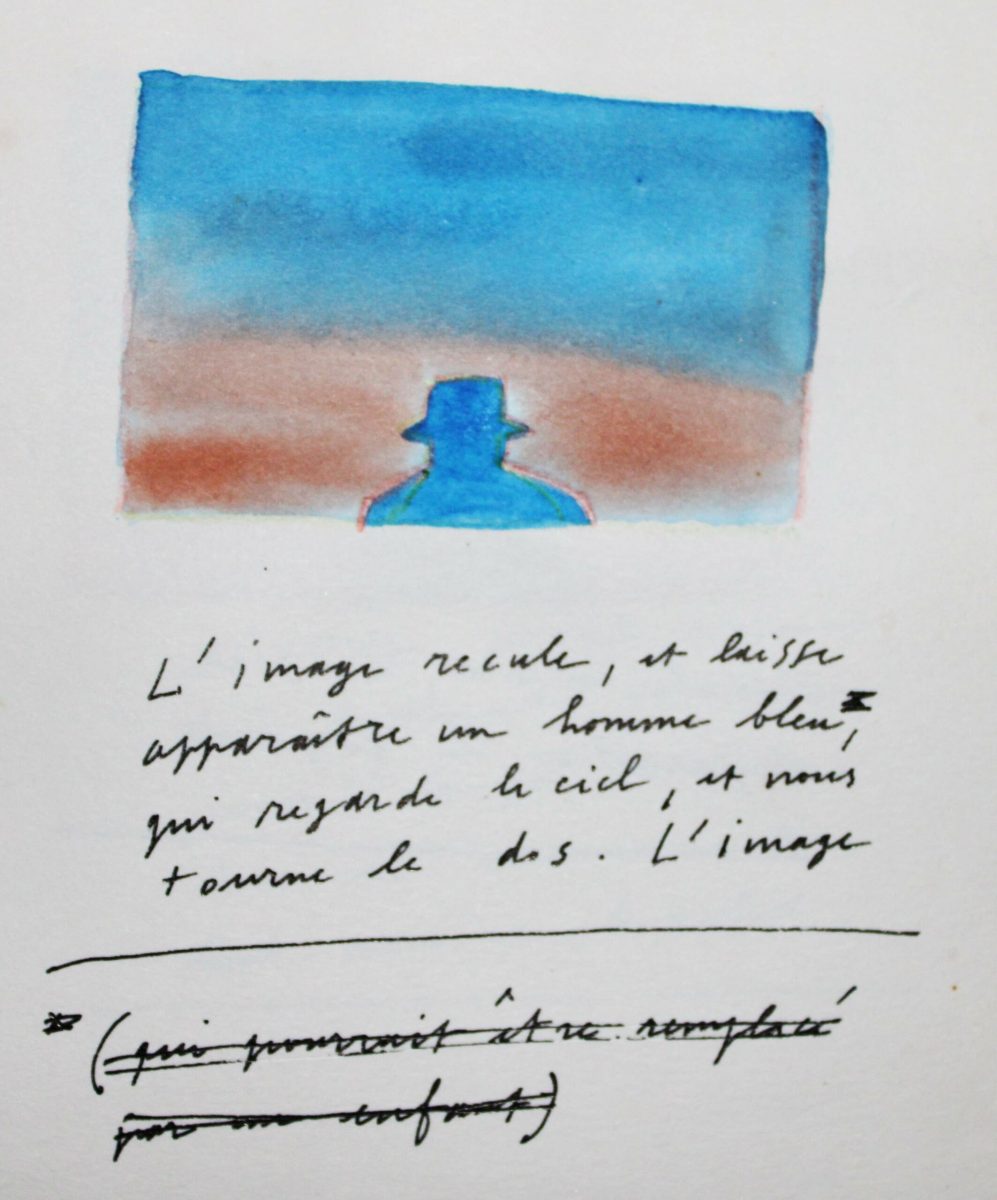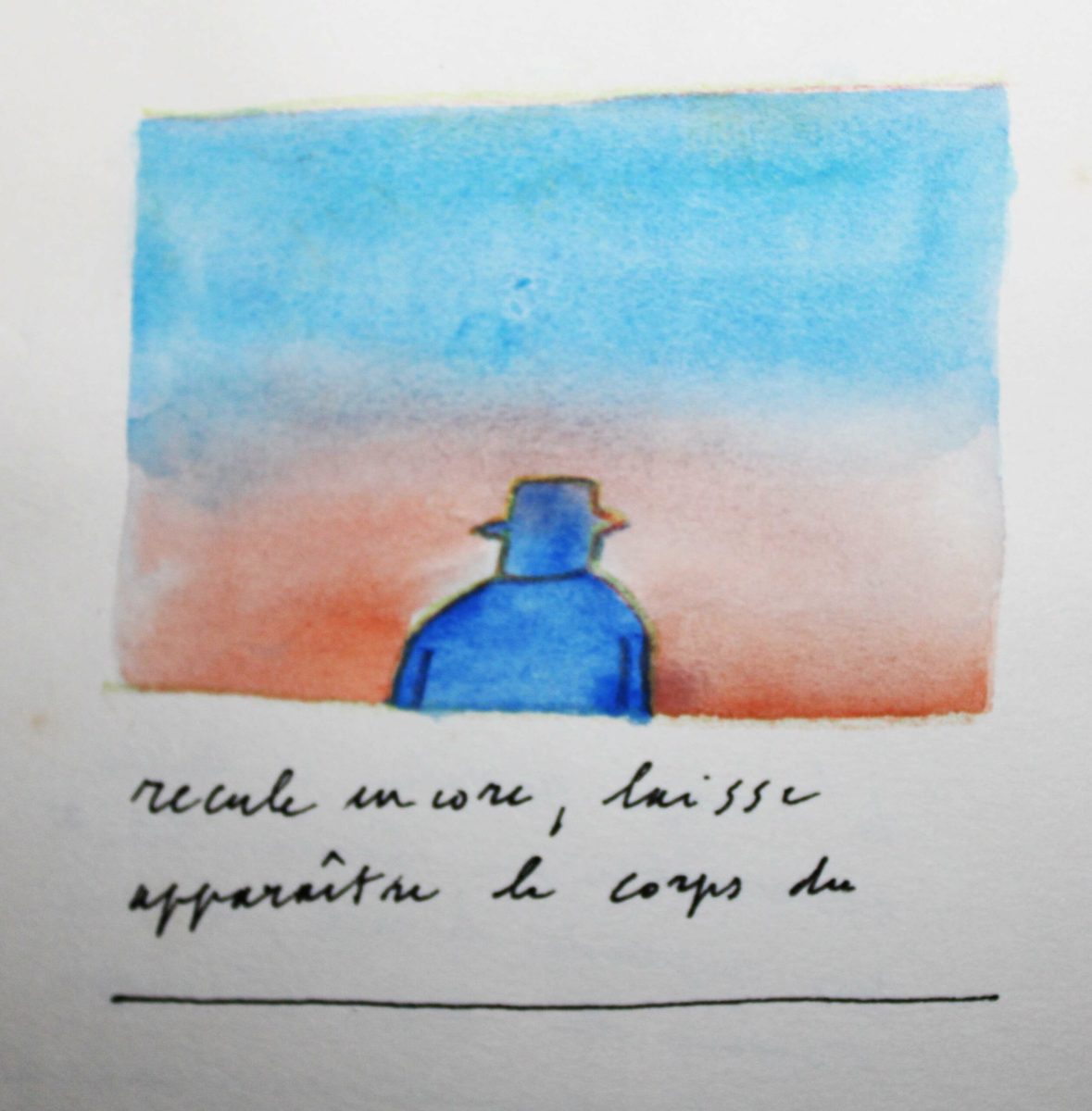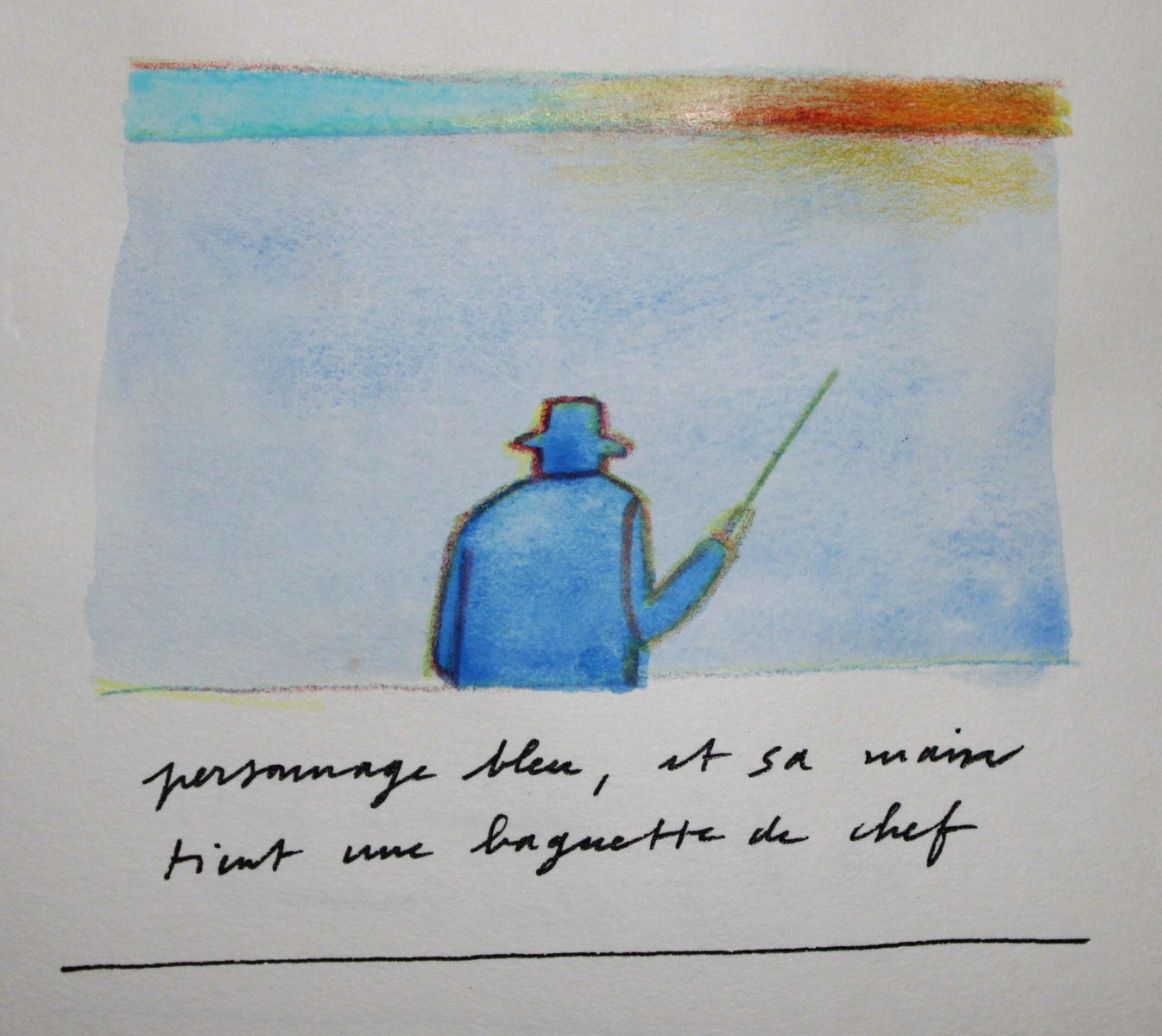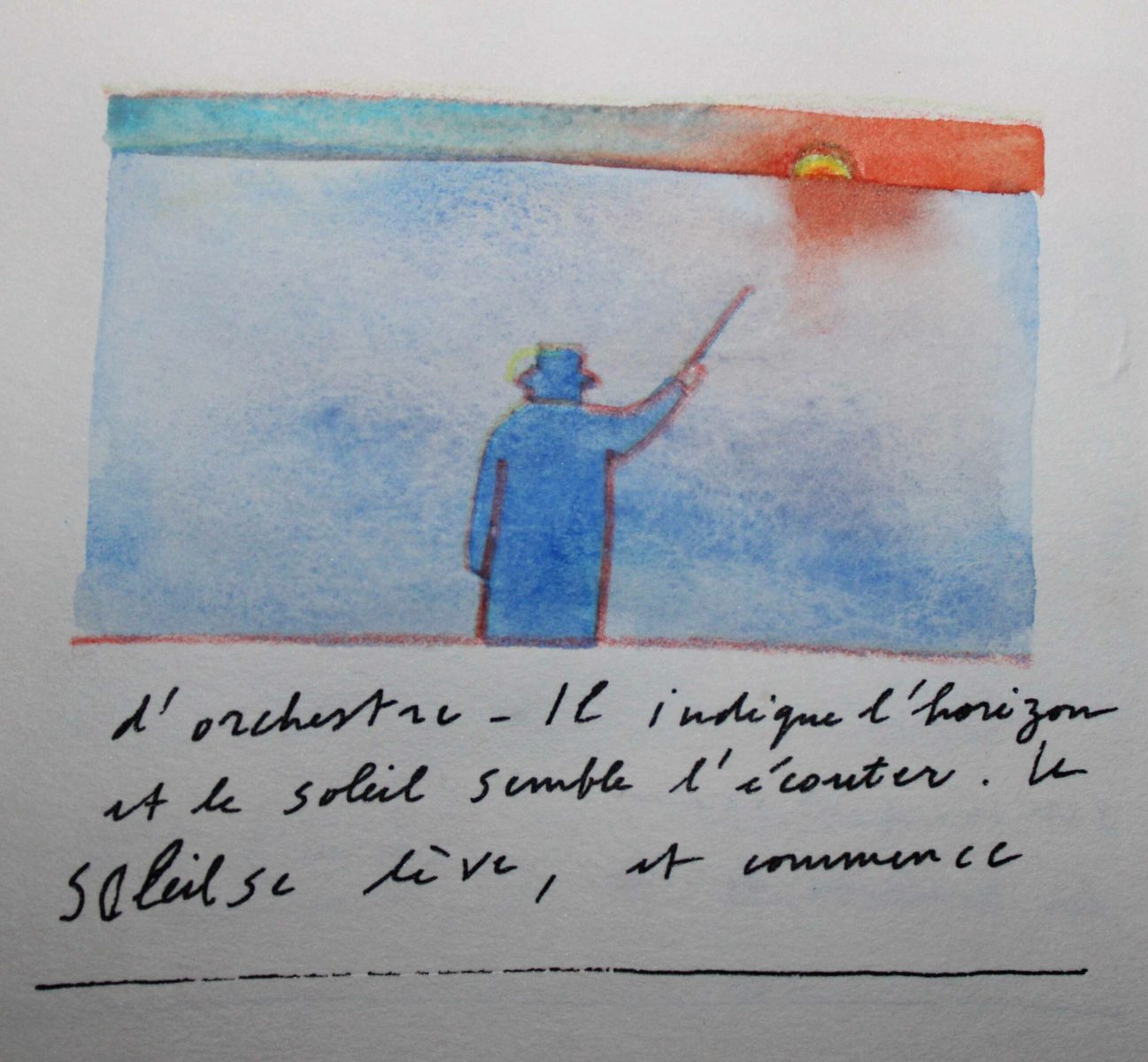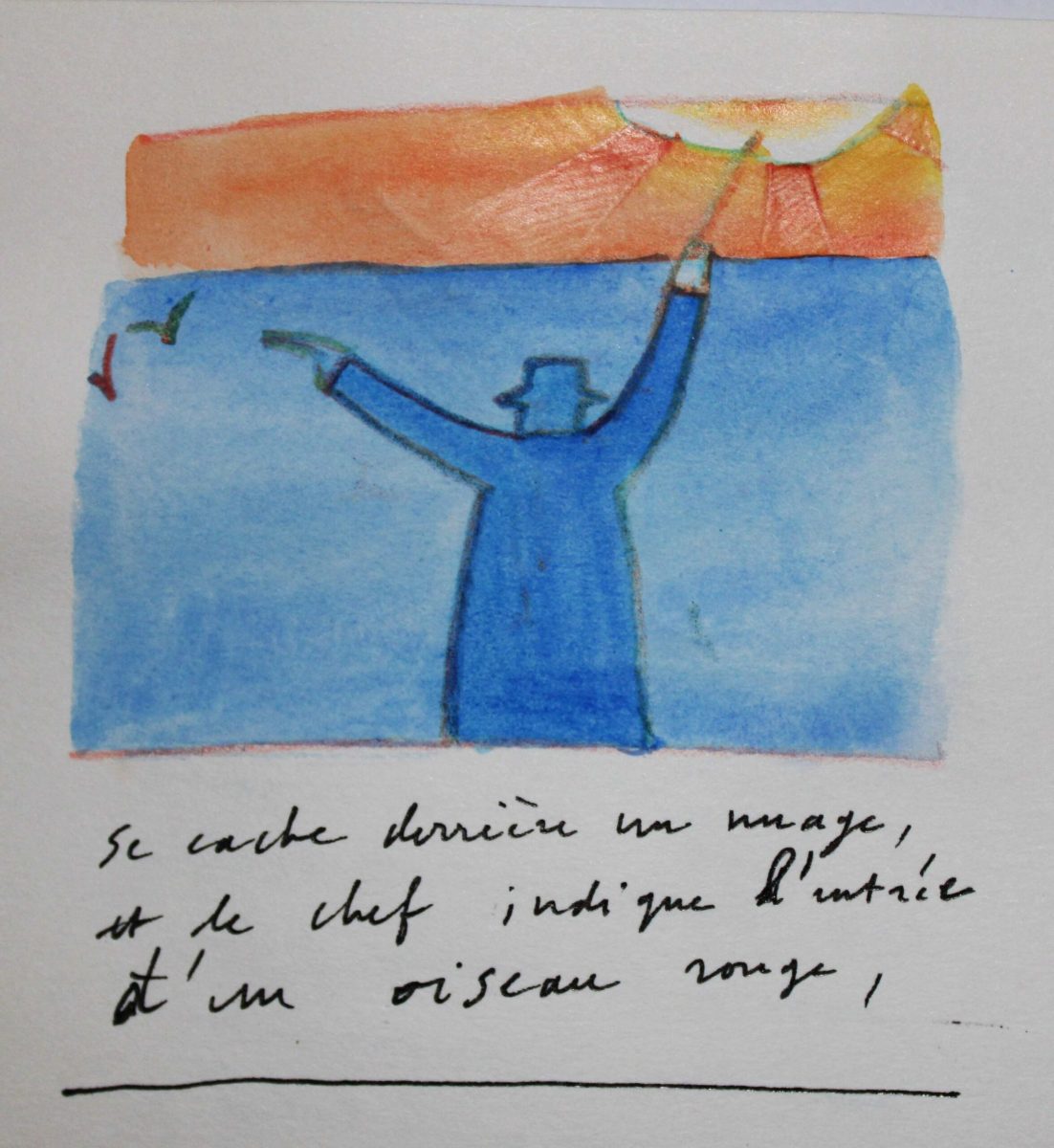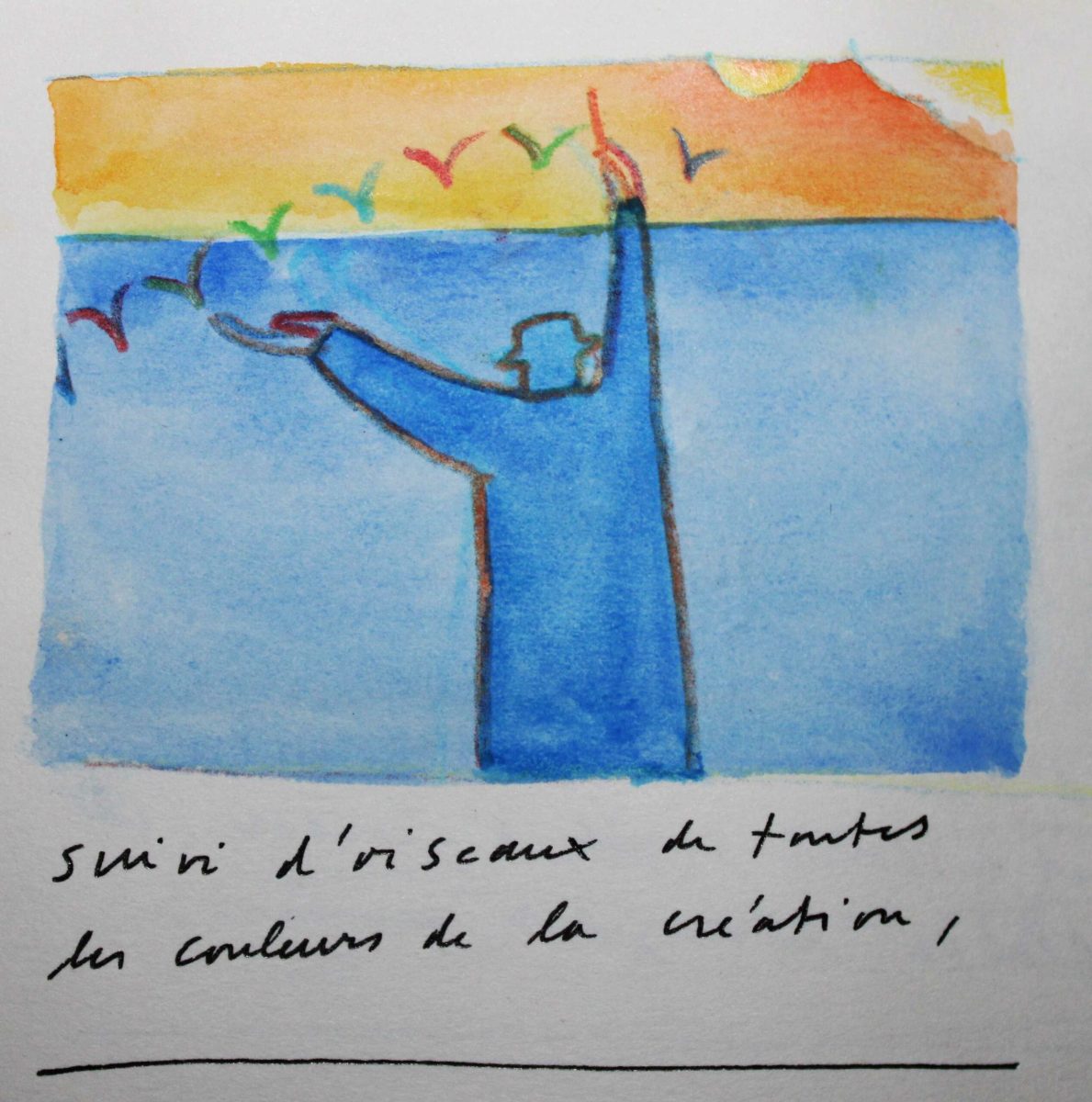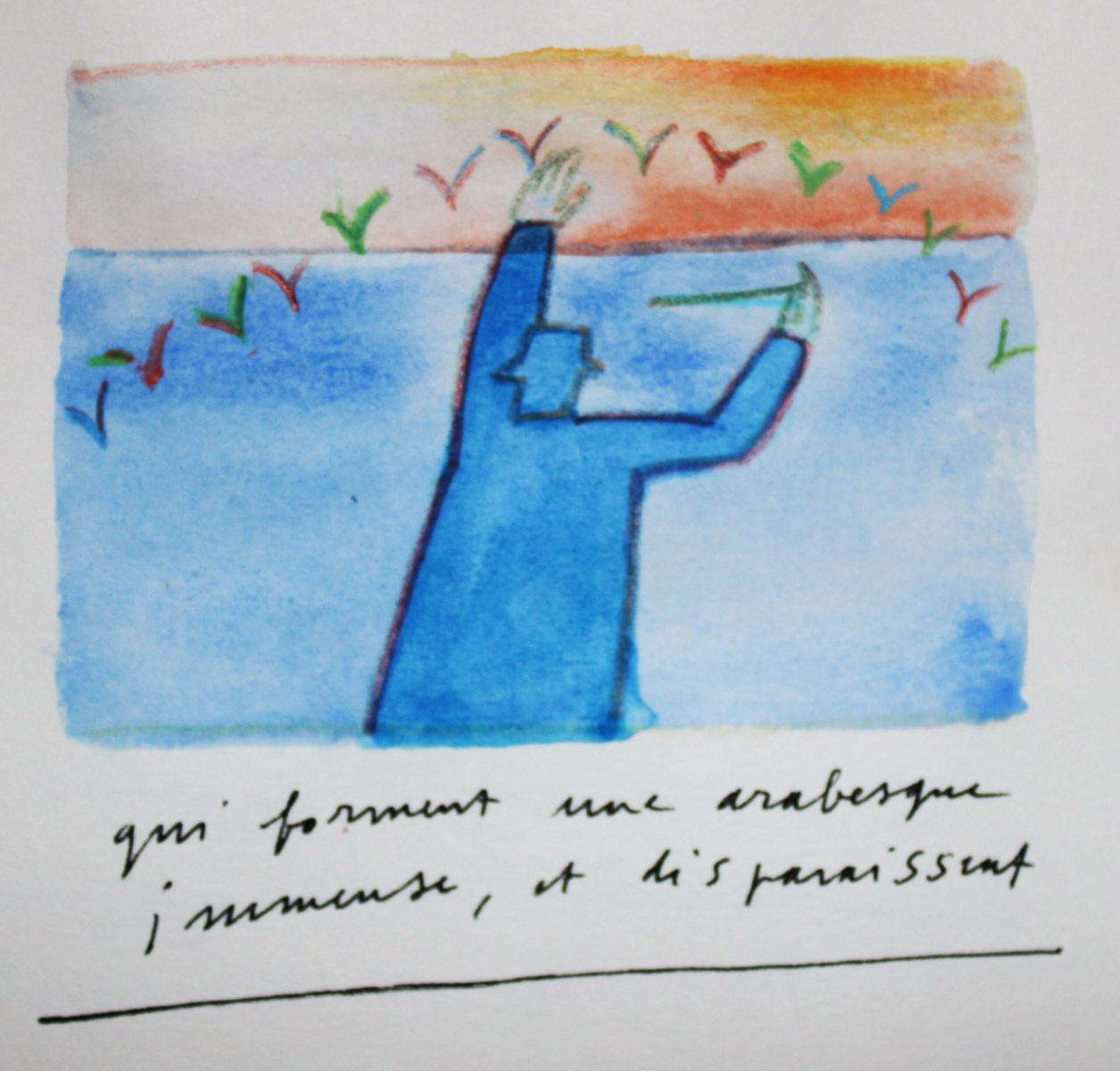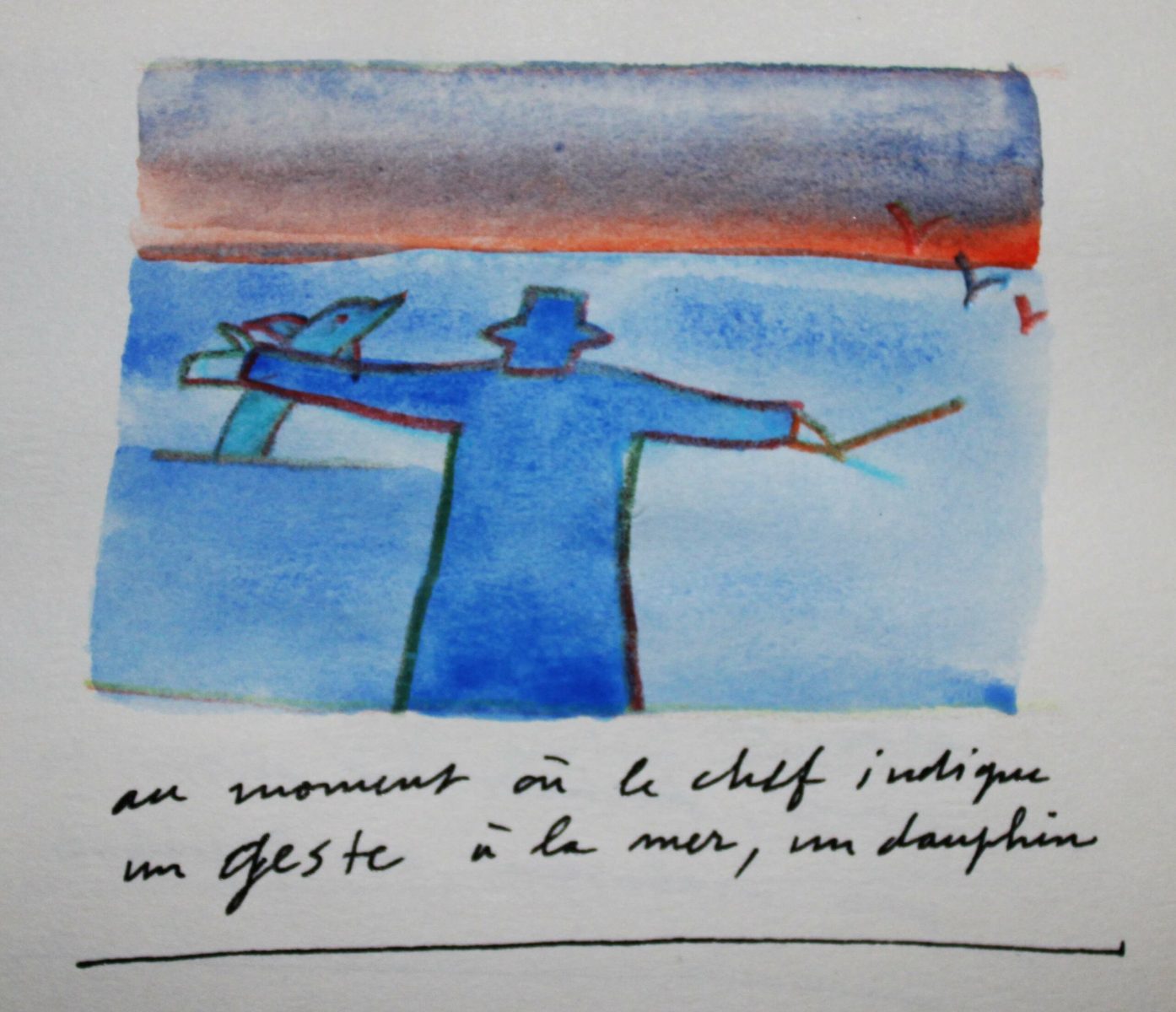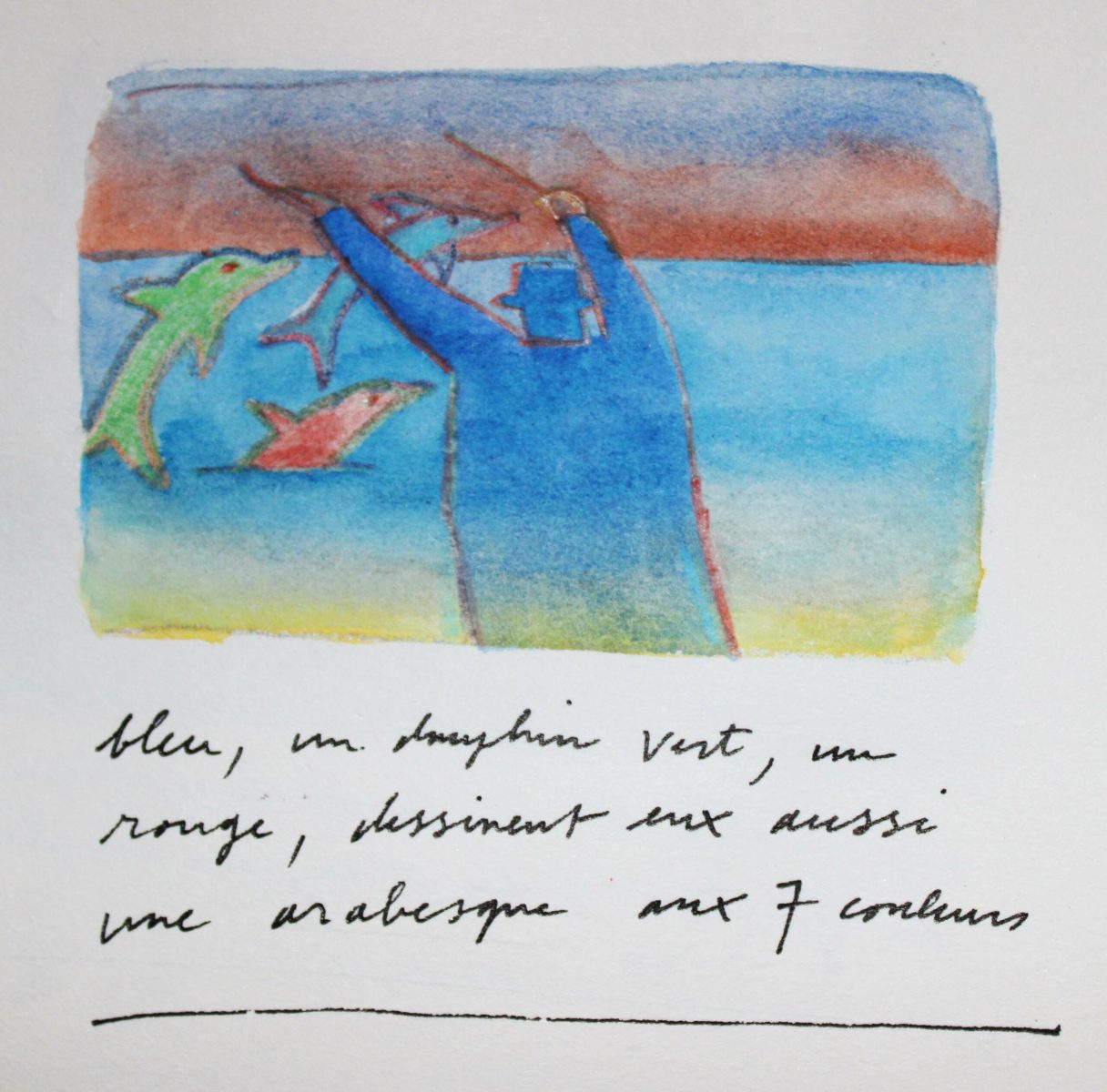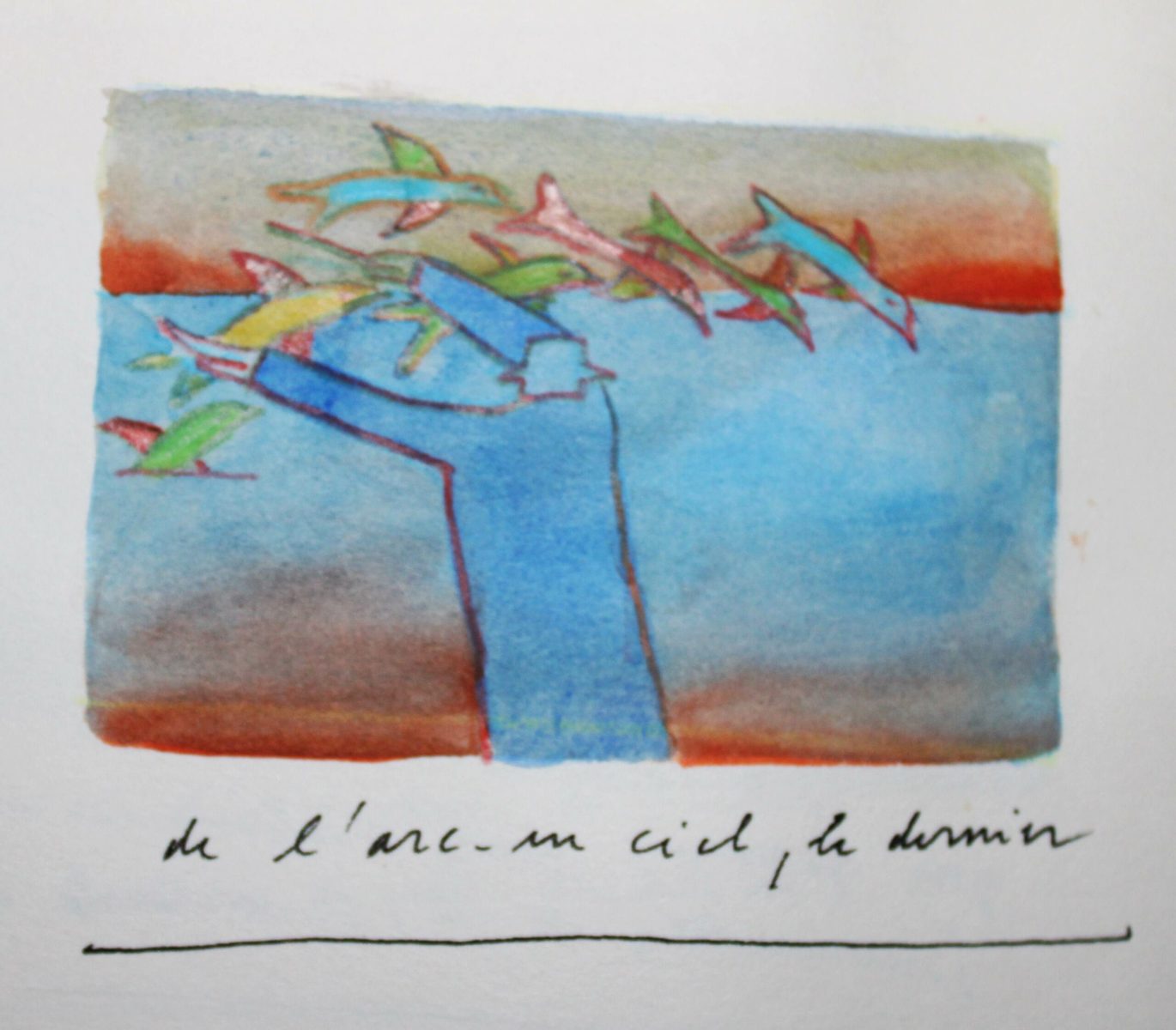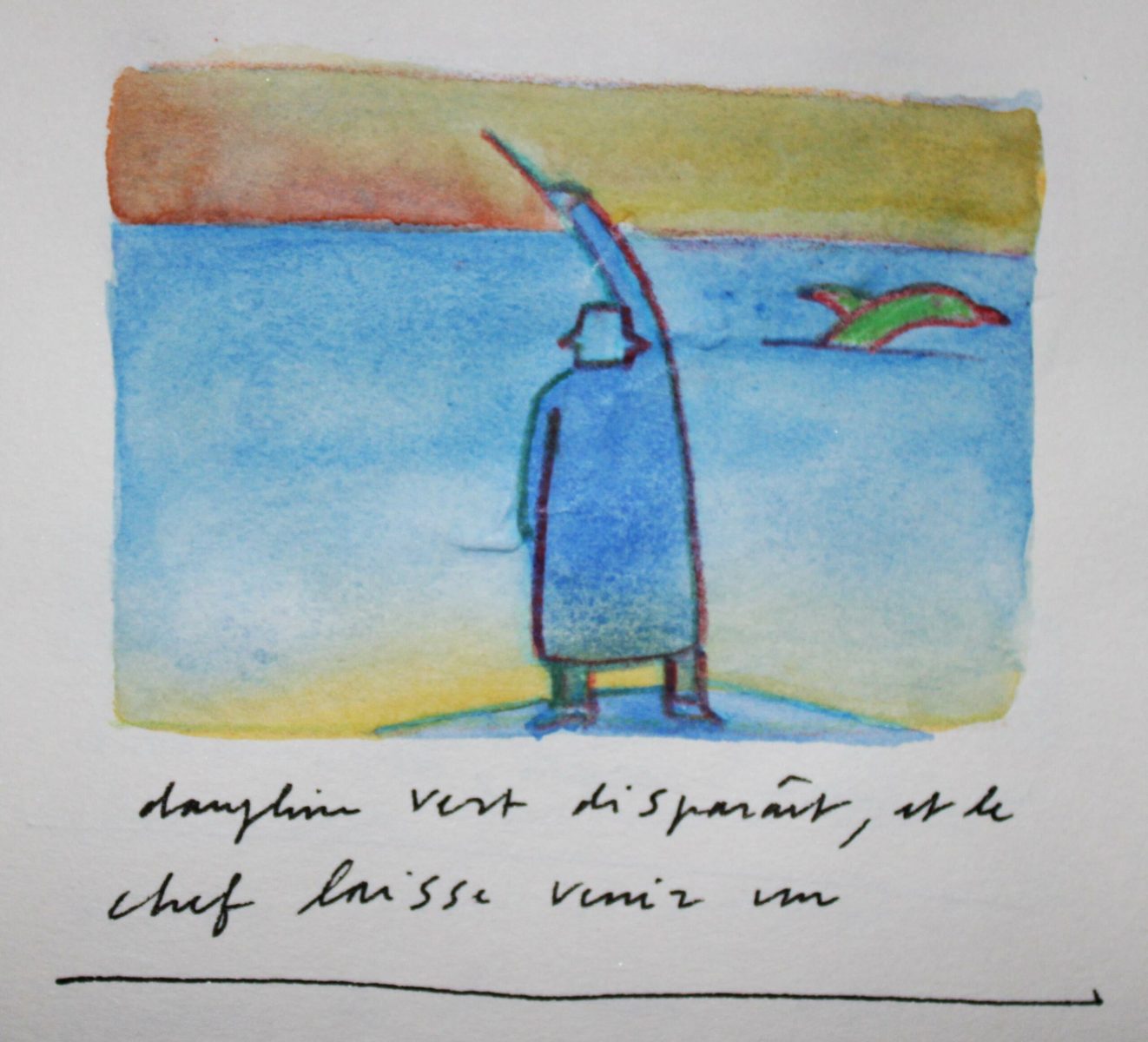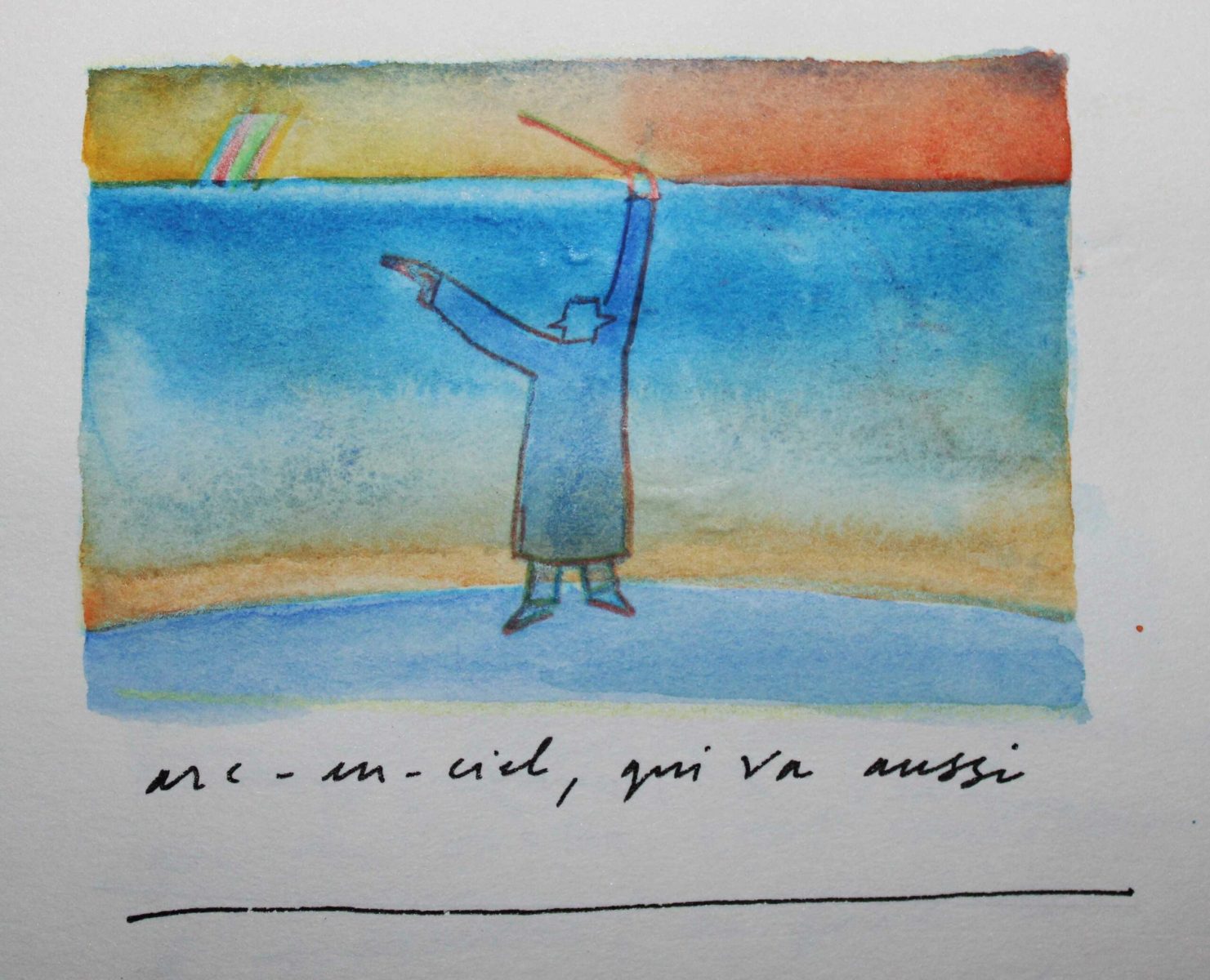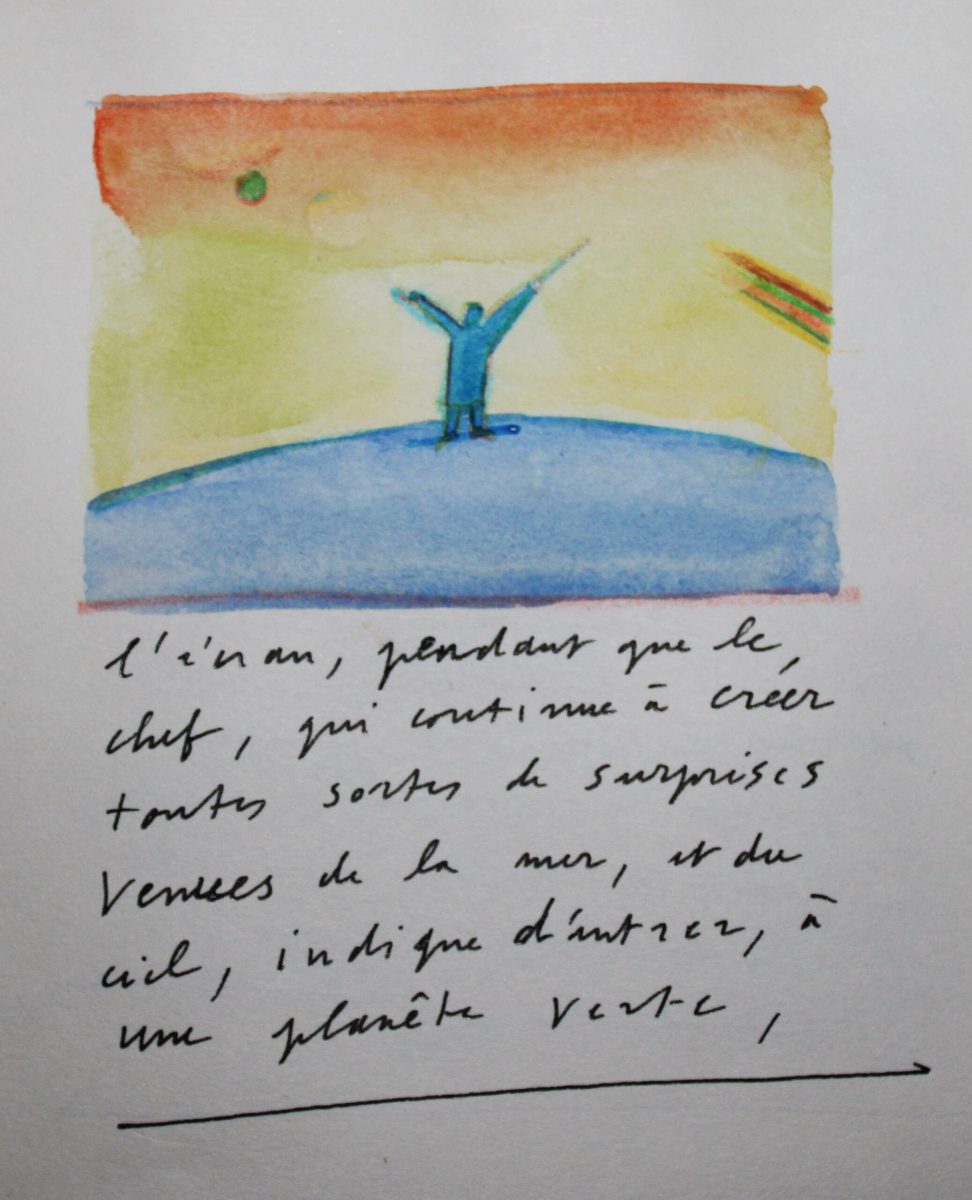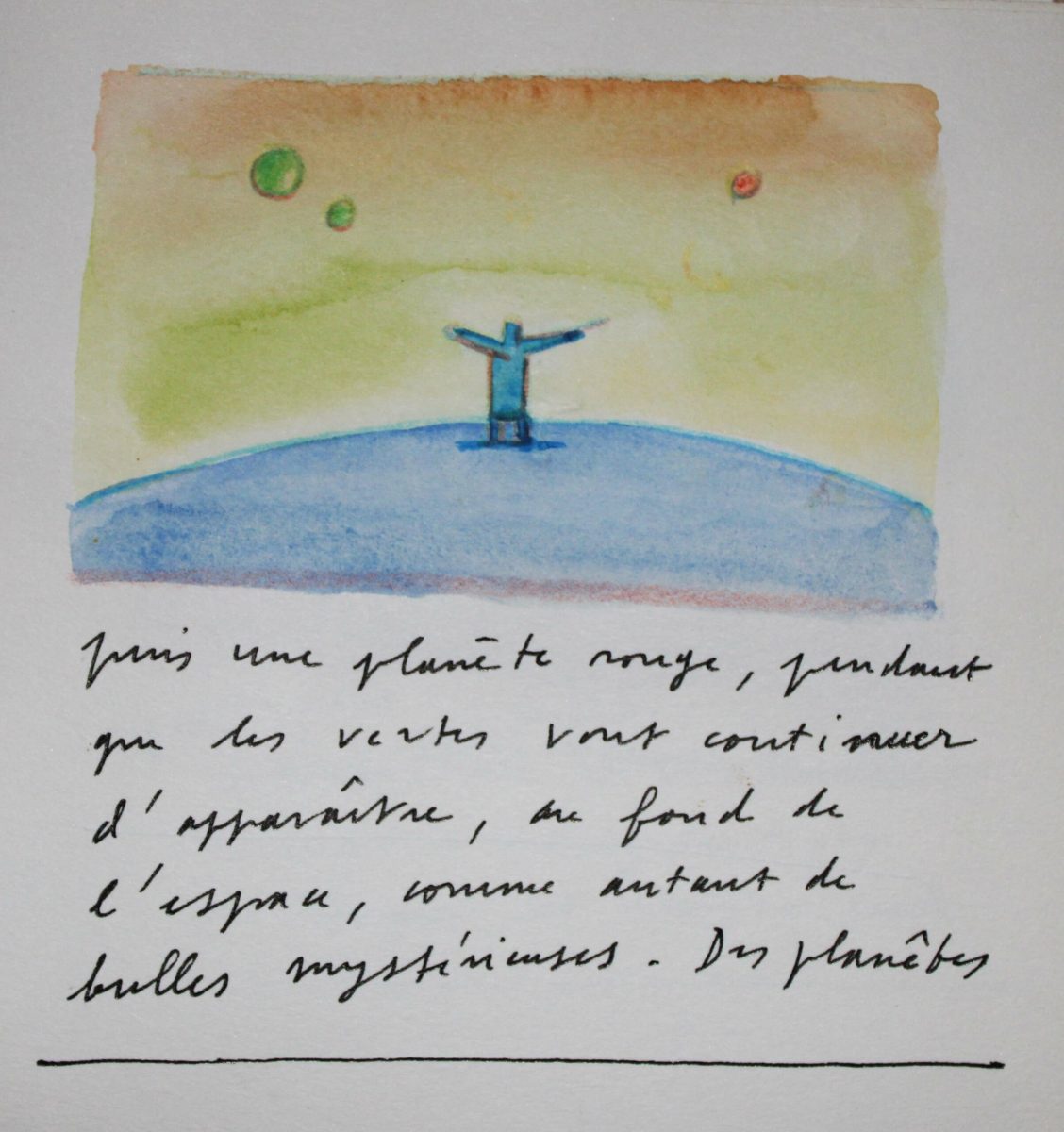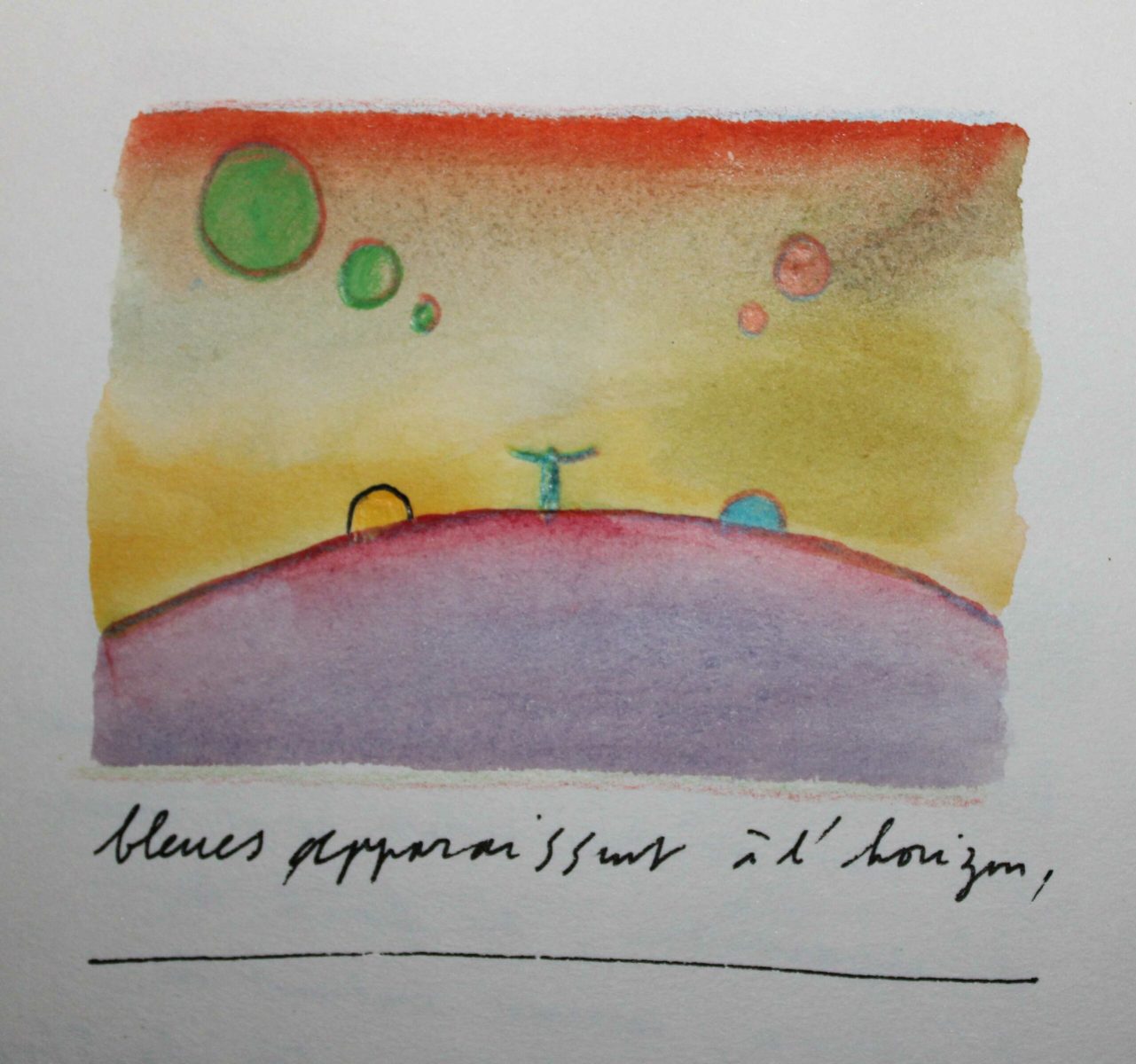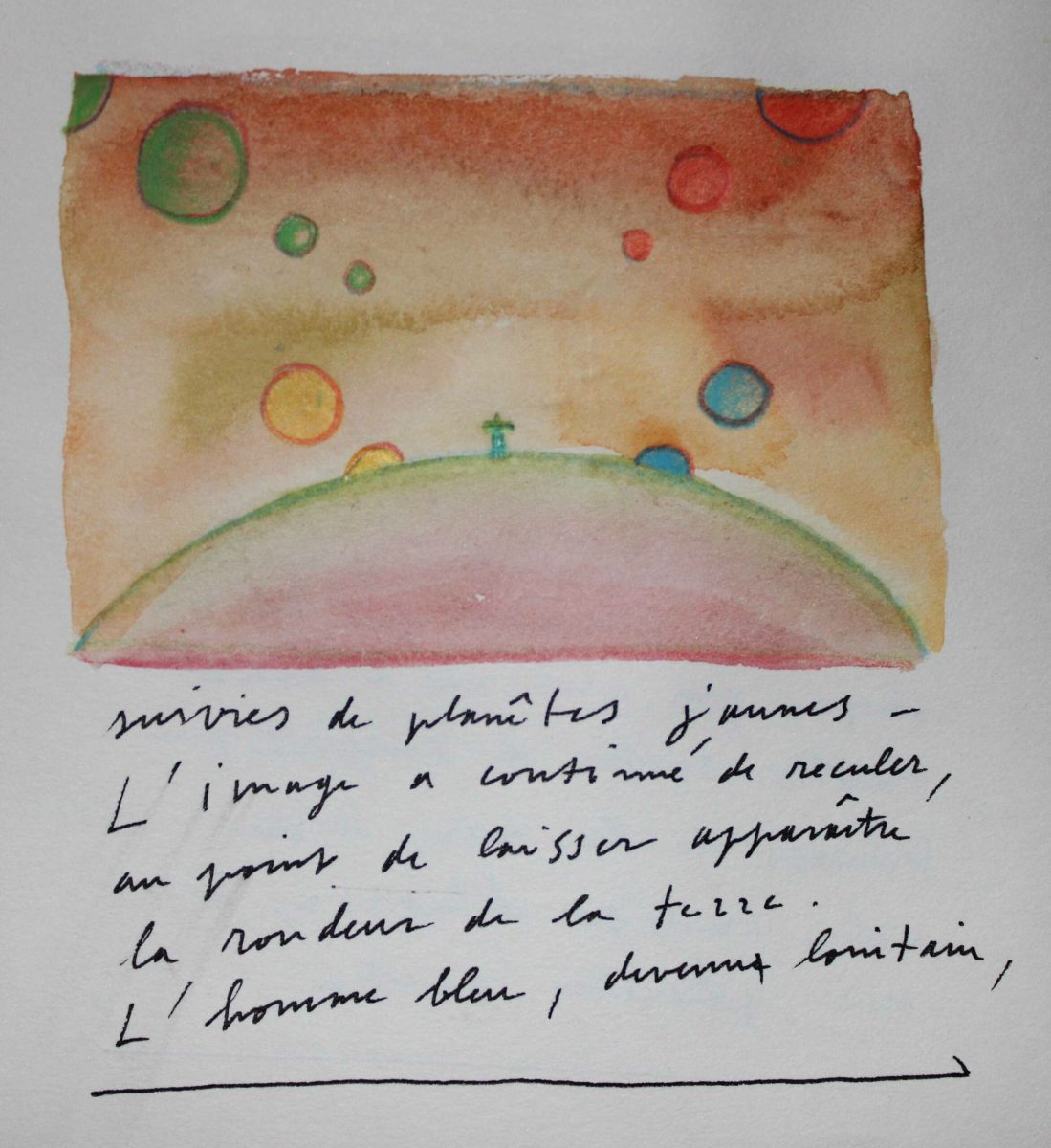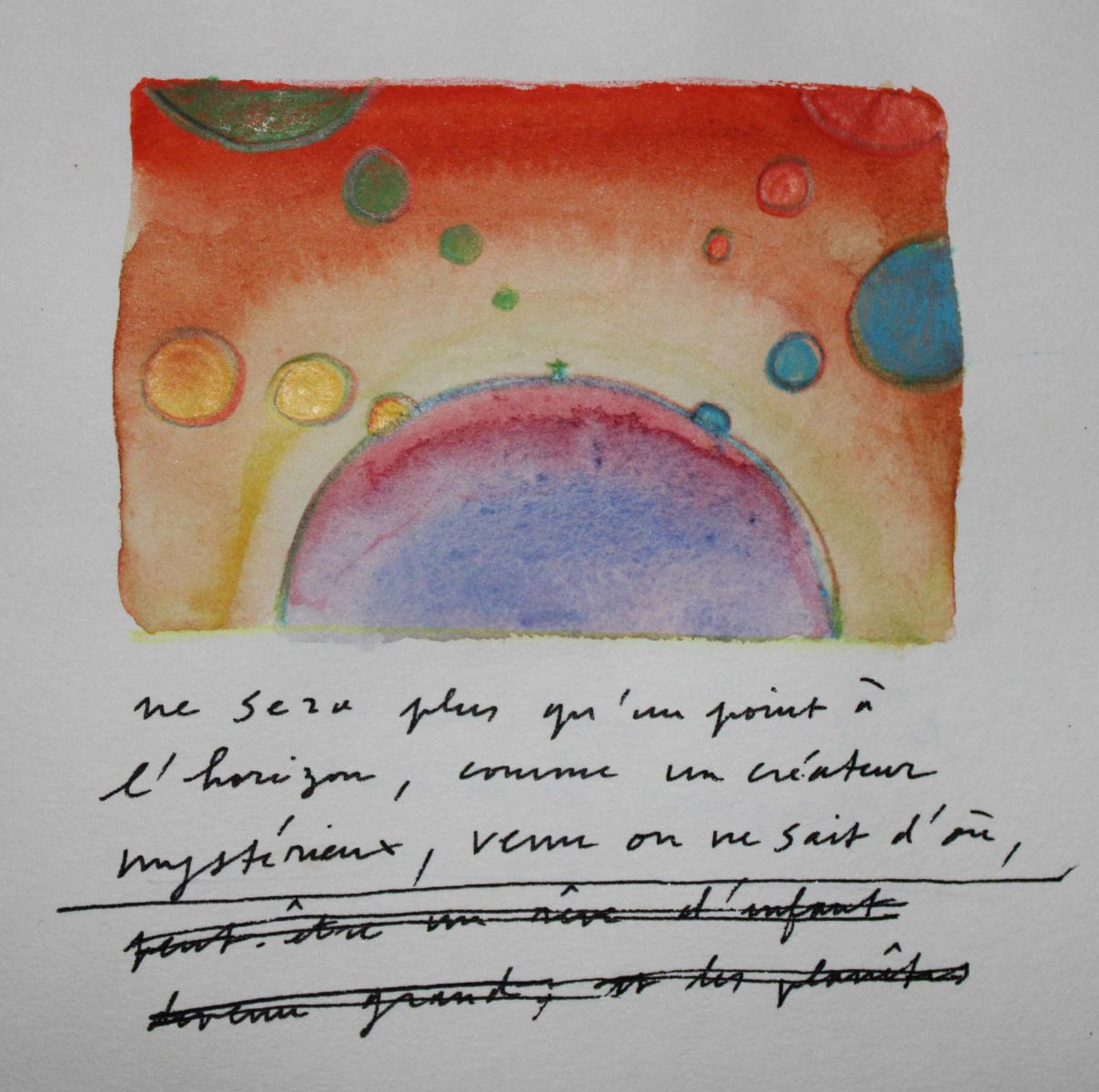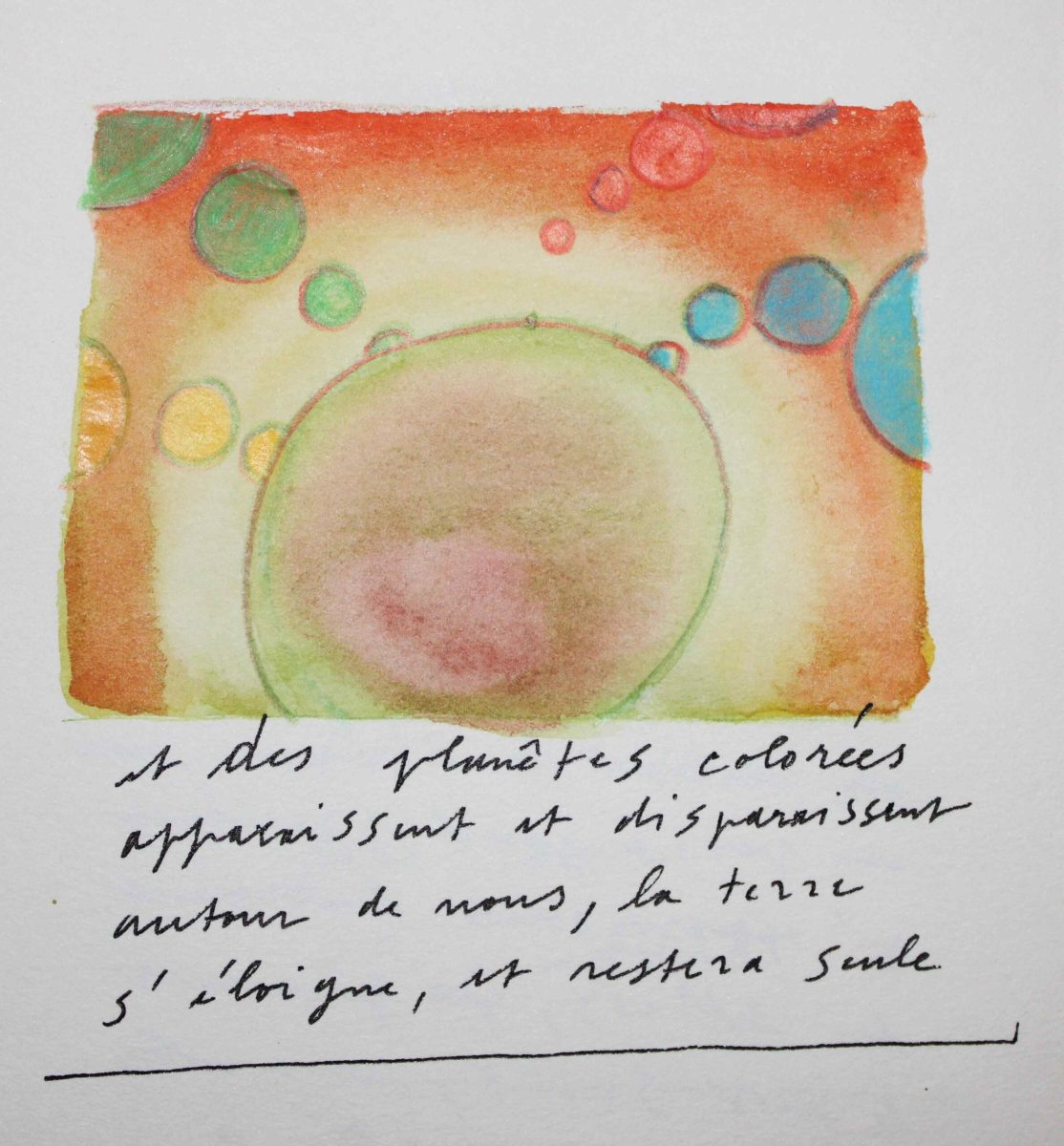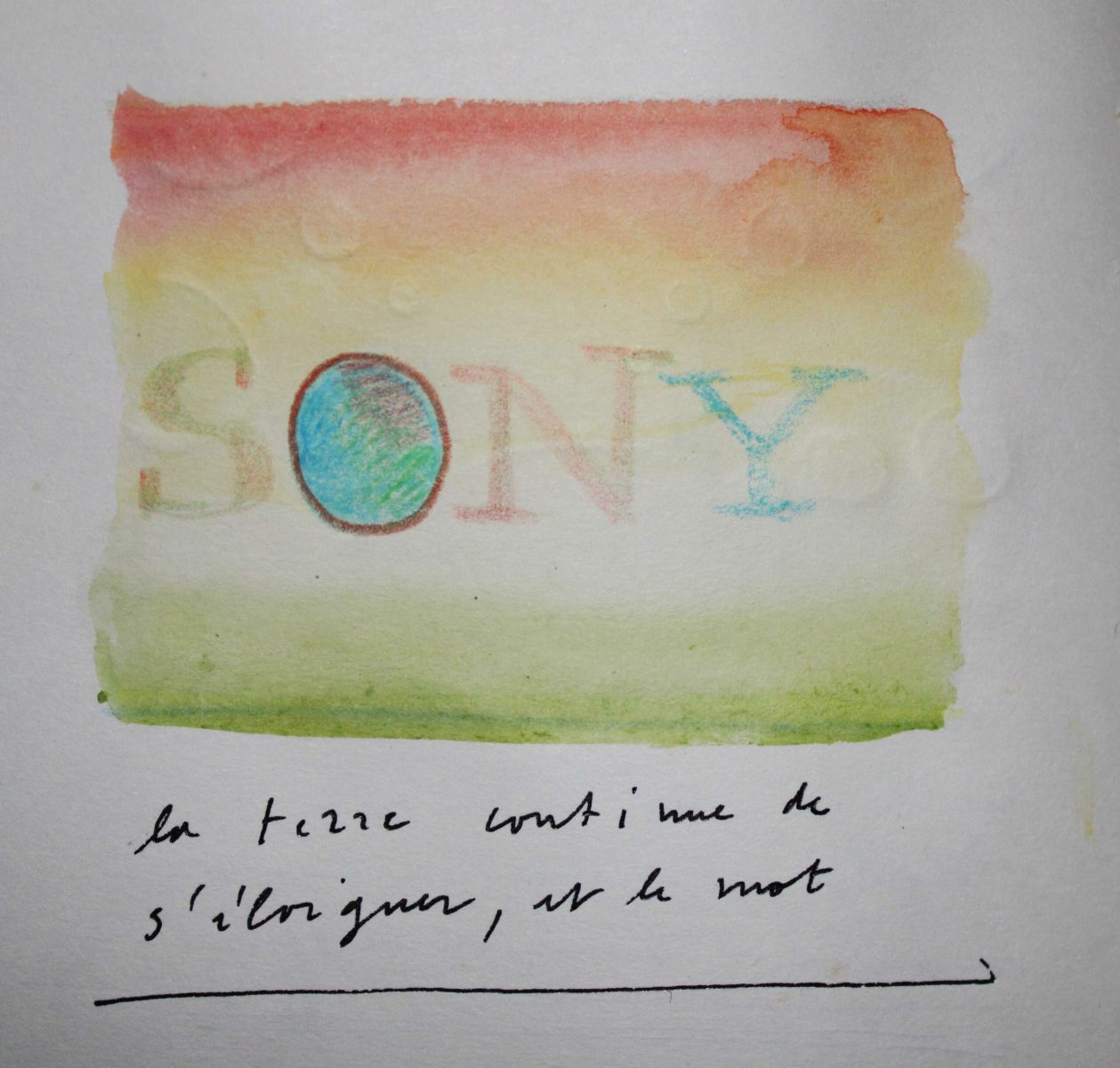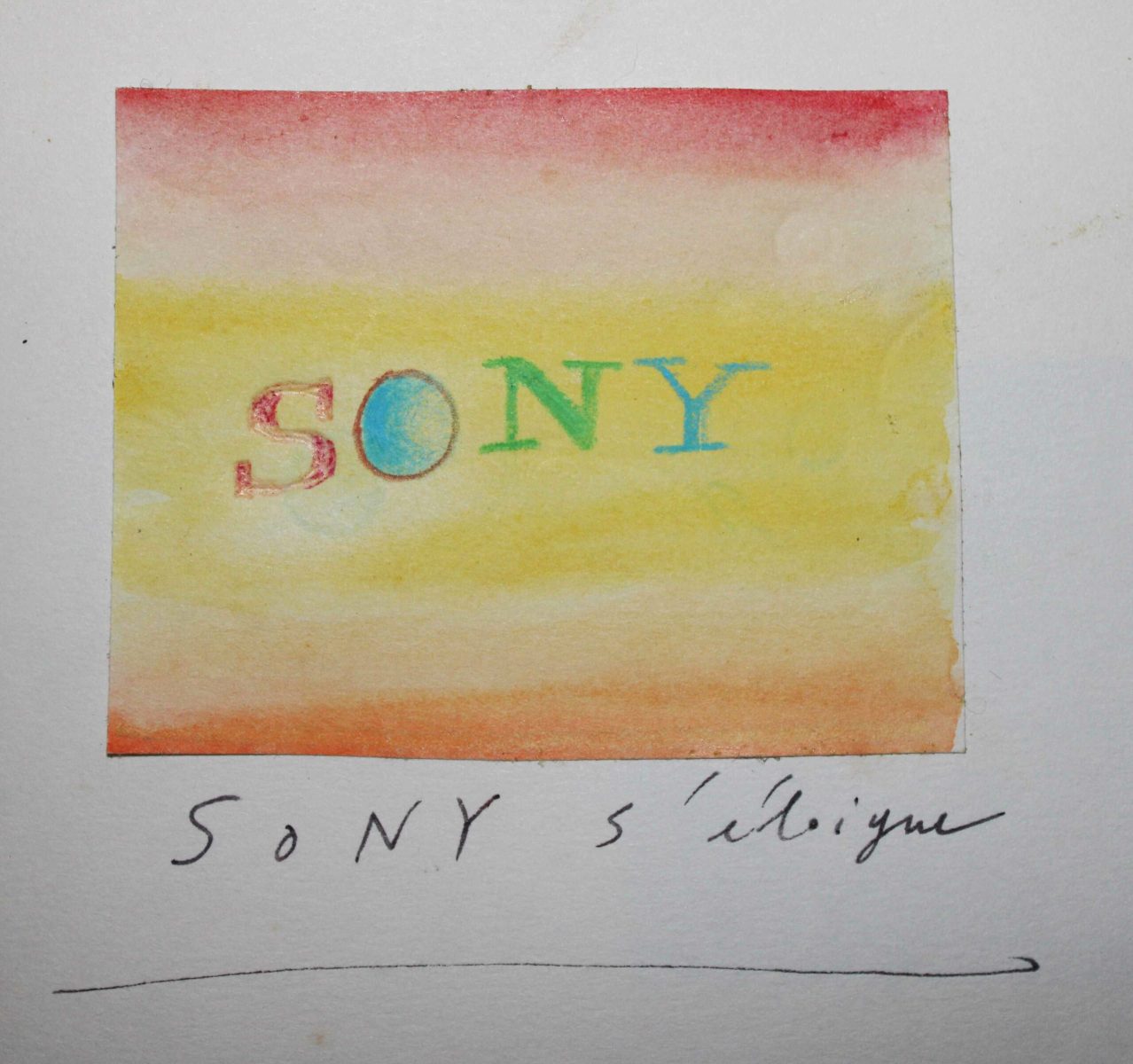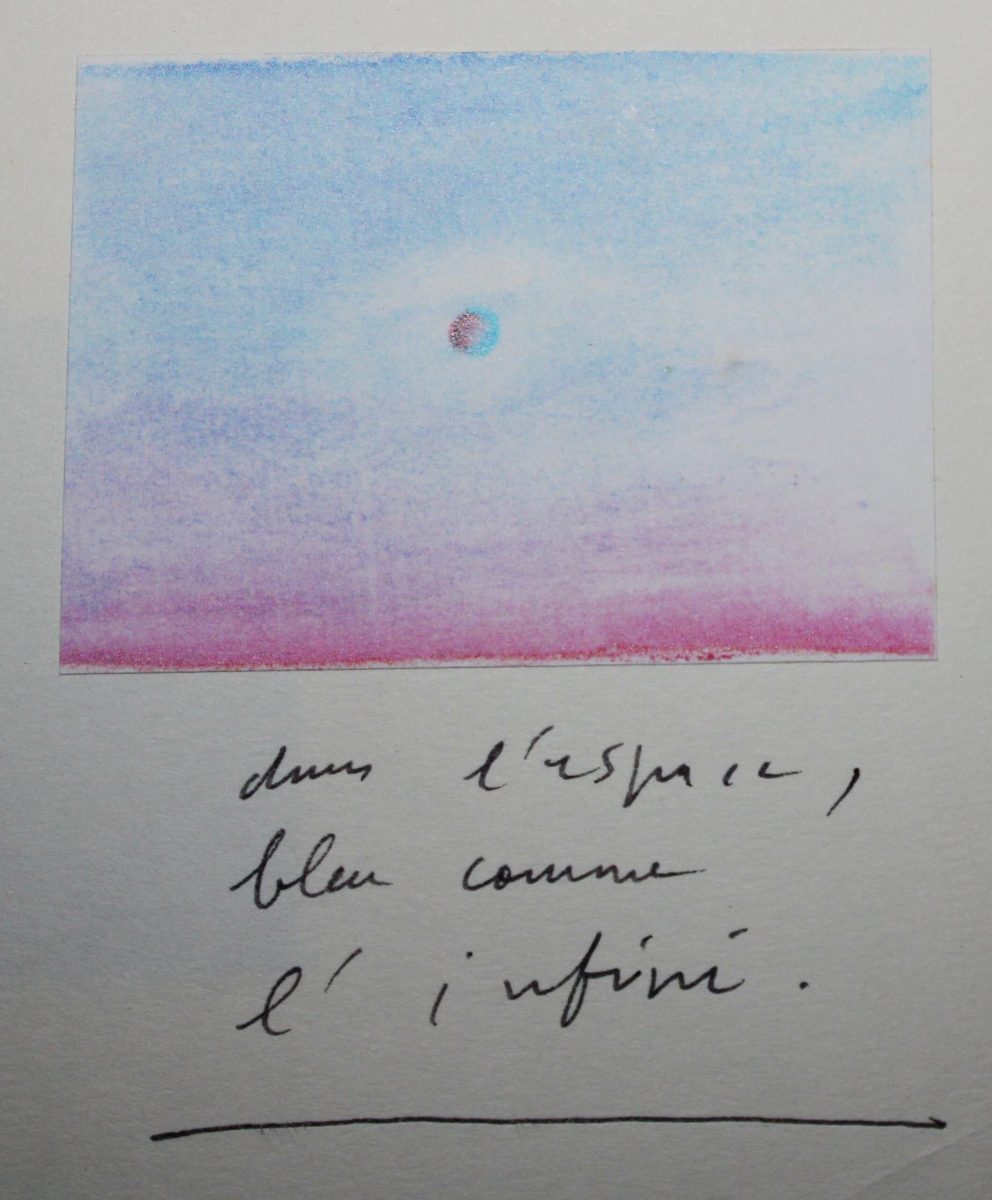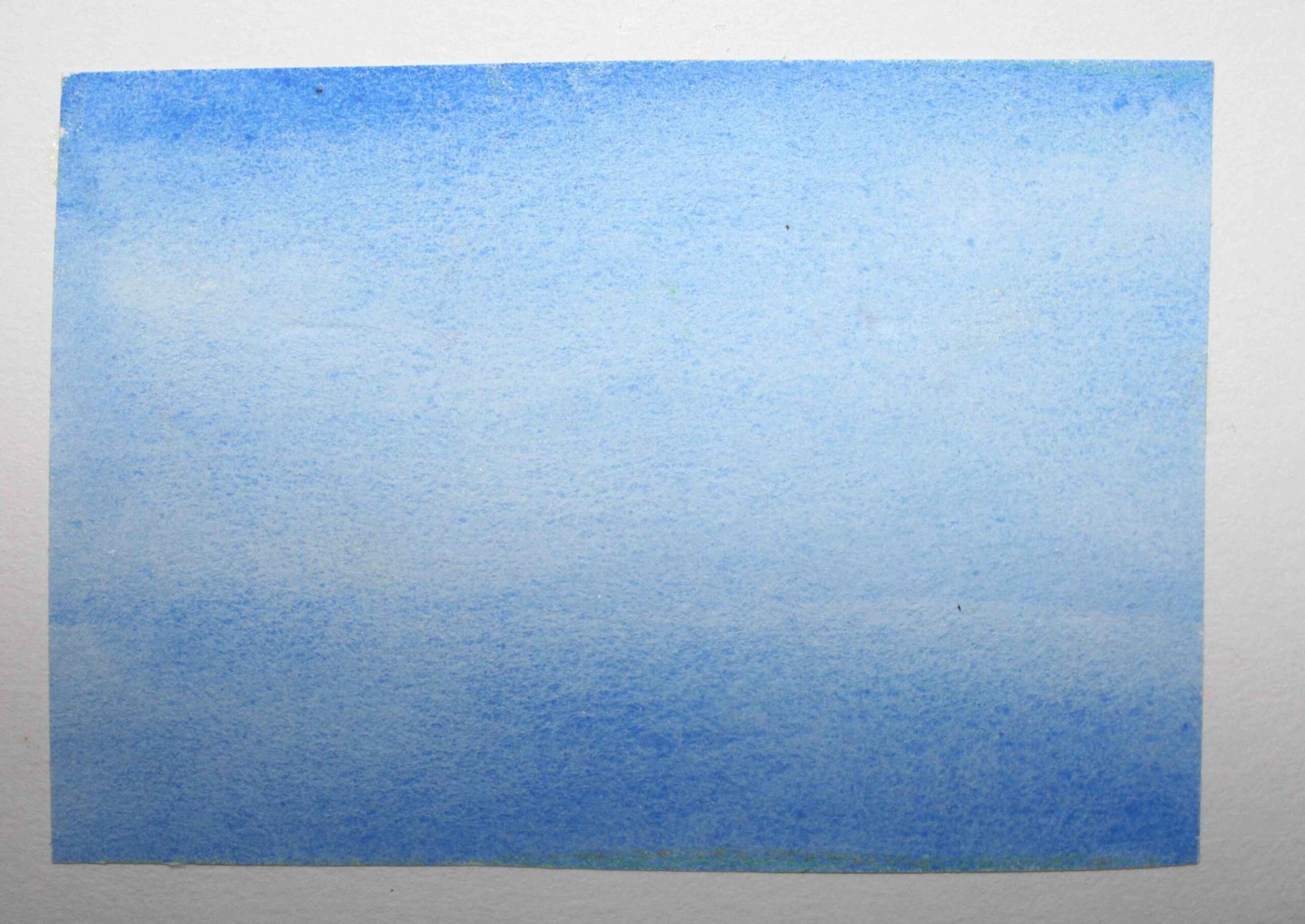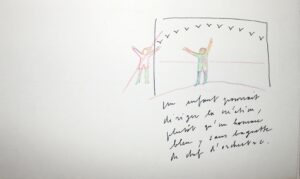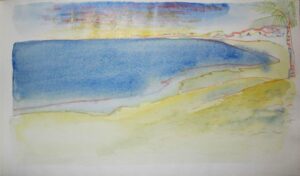Jean-Michel Folon (1934-2005). Projet de film, pour célébrer les 20 ans de SONY. minimum 30 secondes ou 1 minute. No place, February 1973. Story-board of 27 watercolours enhanced with coloured pencil and pastel (3 watercolours mounted) ; size of watercolours : around 5 x 6 cm, on 9 unpaginated ff. and 1 drawing in coloured pencil and black ink, with colour test on verso, on a cut-out sheet [castoff idea], all captioned in ink by the artist; with a fine watercolour of a beach and palm tree (11,5 x 20 cm) at the end of the sketchbook, many blank pages. Bradel-style oblong sketchbook in unbleached cloth(13,5 x 22,2 cm) (Sennelier, fabricant depuis 1887).
The watercolours are of a rare freshness, in harmony with the poetic text: « Le film commence par un ciel bleu immense // L’image recule, et laisse apparaître un homme bleu [(qui pourrait être remplacé par un enfant) en note, biffé], qui regarde le ciel, et nous tourne le dos. L’image // recule encore, laisse apparaître le corps du // personnage bleu, et sa main tient une baguette de chef // d’orchestre. Il indique l’horizon et le soleil semble l’écouter. Le soleil se lève, et commence // à monter dans le ciel, l’image recule toujours très lentement, et reculera jusqu’à la fin du film, dans un mouvement lent arrière. Le soleil // se cache derrière un nuage, et le chef indique l’entrée d’un oiseau rouge, suivi d’oiseaux de toutes les couleurs de la création, // qui forment une arabesque immense, et disparaissent // au moment où le chef indique un geste à la mer, un dauphin // bleu, un dauphin vert, un rouge, dessinent eux aussi une arabesque aux 7 couleurs // de l’arc-en-ciel, le dernier // dauphin vert disparaît, et le chef laisse venir un // arc-en-ciel, qui va aussi // envahir l’image, former // un demi-cercle, et traverser // l’écran, pendant que le chef, qui continue à créer toutes sortes de surprises venues de la mer, et du ciel, indique d’entrer, à une planète verte // puis une planète rouge, pendant que les vertes vont continuer d’apparaître, au fond de l’espace, comme autant de bulles mystérieuses. Des planêtes // bleues apparaissent à l’horizon, // suivies de planêtes jaunes. L’image a continué de reculer, au point de laisser apparaître la rondeur de la terre. L’homme bleu, devenu lointain, // ne sera plus qu’un point à l’horizon, comme un créateur mystérieux, venu on ne sait d’où [peut-être un rêve d’enfant devenu grand, et les planêtes biffé] // et des planêtes colorées apparaissent et disparaissent autour de nous, la terre s’éloigne, et restera seule // au milieu de l’écran, non un peu à gauche, pendant qu’apparaissent lentement des lettres, qui formeront le mot SONY, avec notre terre comme lettre O, // la terre continue de s’éloigner, et le mot // SONY s’éloigne // dans l’espace, bleu comme l’infini. »
[“The film begins with an immense blue sky // The image recedes, revealing a blue man [(who could be replaced by a child) in the note, strikethrough], looking up at the sky, with his back to us. The image // moves back again, revealing the body of the // blue figure, and his hand is holding a conductor’s // baton. He is pointing to the horizon and the sun seems to be listening. The sun rises, and begins // to climb into the sky, the image still moving backwards very slowly, and will continue to do so until the end of the film, in a slow backward movement. The sun // hides behind a cloud, and the leader indicates the entrance of a red bird, followed by birds of all the colours of creation, // which form an immense arabesque, and disappear // just as the leader indicates a gesture to the sea, a blue // dolphin, a green dolphin, a red one, also drawing an arabesque in the 7 colours // of the rainbow, the last // green dolphin disappears, and the leader lets a rainbow // come in, which will also // invade the image, form // a semi-circle, and cross // the screen, while the leader, who continues to create all sorts of surprises from the sea and sky, indicates the entrance of a green planet // then a red planet, while the green ones continue to appear, at the bottom of space, like so many mysterious bubbles. Blue planets // appear on the horizon, // followed by yellow planets. The image continued to recede, revealing the roundness of the earth. The blue man, now far away, // will be no more than a dot on the horizon, like a mysterious creator from who knows where [perhaps a child’s dream come true, and the planets crossed out] // and coloured planets appear and disappear around us, the earth moves away, and will remain alone // in the middle of the screen, not a little to the left, while letters slowly appear, which will form the word SONY, with our earth as the letter O, // the earth continues to move away, and the word // SONY moves away // into space, blue as infinity. “]
On the castoff page, the drawing of a child with his arms raised in front of the horizon, leading a flock of birds, is captioned: « Un enfant pourrait diriger la création, plutôt qu’un homme bleu, sans baguette de chef d’orchestre. » [“A child could direct creation, rather than a blue man without a conductor’s baton”.] Note that a sketch of the child is deleted.
The Sony name had been around since 1955, and one of its major innovations at the time was the colour video cassette in 1971, which probably explains the artist’s emphasis on colours (blue man, birds, dolphins, multicoloured planets, rainbow and infinite blue space). Folon’s project for Sony never came to fruition, but the artist drew inspiration from it for his poetic design for the French channel Antenne 2 in 1975, particularly the opening and closing credits, which will live long in the memories of this generation: the blue man (who starts to fly like a bird), the planets, the earth moving away into infinite blue space…
Our poetic storyboard also provides valuable insights into the artist’s creative process.Folon avait une prédilection pour l’aquarelle : « Je préfère peut-être les aquarelles aux peintures, si j’y pense, confie-t-il lors d’une interview, parce que justement cette sensation de la vie dans l’instant est une chose unique […] et je crois que quand on fait une aquarelle c’est l’envie qu’elle ne sèche jamais parce que l’aquarelle c’est beaucoup plus que la représentation de la vie, c’est la vie. » [“I perhaps prefer watercolours to paintings, if I think about it,‘ he confides in an interview, ’precisely because this feeling of life in the moment is a unique thing […] and I think that when you do a watercolour you want it never to dry because watercolours are much more than the representation of life, they are life”.] https://youtu.be/09XLZj_Nvd4
An exceptional document.
18 000 €
